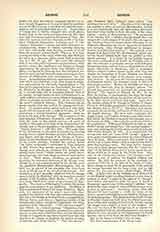

George Hamartolus, a monk at Constantinople under Michael III (842-867) and the author of a chronicle of some importance. Hamartolus is not his name but the epithet he gives to himself in the title of his work: “A compendious chronicle from various chroniclers and interpreters, gathered together and arranged by George, a sinner (hupo Georgiou hamartolou)”. It is a common form among Byzantine monks. Krumbacher (Byz. Litt., 358) protests against the use of this epithet as a name and proposes (and uses) the form Georgios Monachos. Nothing is known about him except from the internal evidences of his work, which establishes his period (in the preface he speaks of Michael III as the reigning emperor) and his calling (he refers to himself several times as a monk). The chronicle consists of four books. The first treats of profane history from Adam to Alexander the Great; the second, of the history of the Old Testament; the third, of Roman history from Julius Cesar to Constantine; and the fourth down to the author’s own time. As usually in the case of such medieval chronicles, the only part to be taken seriously is the account of more or less contemporary events. The rest is interesting as an example of Byzantine ideas on the subjects, and of the questions that most interested Byzantine monks. George describes his ideal and principles in the preface. He has used ancient and modern sources (all Greek, of course), has especially consulted edifying works, and has striven to tell the truth rather than to please the reader by artistic writing. But of so great a mass of material he has chosen only what is most useful and necessary. In effect, the questions that seemed most useful and necessary to ecclesiastical persons at Constantinople in the ninth century are those that are discussed. There are copious pious reflections and theological excursuses. He writes of how idols were invented, the origin of monks, the religion of the Saracens, and especially of the Iconoclast controversy that was just over. Like all monks he hates Iconoclasts. The violence with which he speaks of them shows how recent the storm had been and how the memory of Iconoclast persecutions was still fresh when he wrote. He writes out long extracts from Greek Fathers. The first book treats of an astonishingly miscellaneous collection of persons—Adam, Nimrod, the Persians, Chaldees, Brahmins, Amazons, etc. In the second book, too, although it professes to deal with Bible history only, he has much to say about Plato and philosophers in general. George Hamartolus ended his chronicle with the year 842, as a colophon in most manuscripts attests. Various people, among them notably “Symeon Logothetes”, who is probably Symeon Metaphrastes, the famous writer of saints’ lives (tenth century, see Krumbacher, 358), continued his history to later dates—the longest continuation reaches to 948. In spite of his crude ideas and the violent hatred of Iconoclasts that makes him always unjust towards them, his work has considerable value for the history of the last years before the schism of Photius. It was soon translated into Slav languages (Bulgarian and Servian) and into Georgian. In these versions it became a sort of fountain-head for all early Slav (even Russian) historians. As a very popular and widely consulted book it has been constantly reedited, corrected, and rearranged by anonymous scribes, so that the reconstruction of the original work is “one of the most difficult problems of Byzantine philology” (Krumbacher, 355).
Combefis first published the last part of Book IV of the chronicle and the continuation (813-948) under the title, Bioi ton neon Basileon, in the “Maxima bibliotheca (Scriptores post Theophanem)” (Paris, 1685; reprinted, Venice, 1729). The first edition of the whole work was edited by E. de Muralt: “Georgii monachi, dicti Hamartoli, Chronicon ab orbe condito ad annum p. chr. 842 et a diversis scriptoribus usq. ad ann. 1143 continuatum” (St. Petersburg, 1859). This is the edition reprinted in Migne, P.G., CX, with a Latin translation. It does not represent the original text, but one of the many modified versions (from a Moscow twelfth-century MS.), and is in many ways deficient and misleading (see Krumbacher’s criticism in “Byz. Litt.”, p. 357). A critical edition is still wanted.
ADRIAN FORTESCUE

